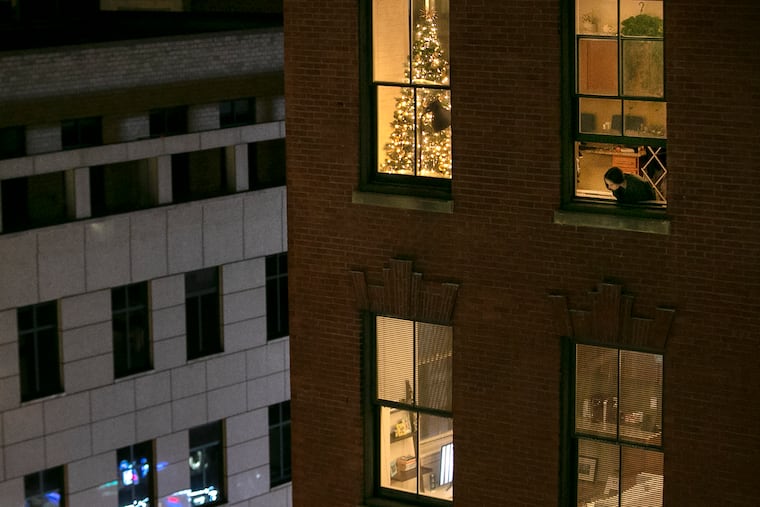Your pandemic safety guide to the holidays | Coronavirus Newsletter
Plus, a tiny central Pa. county has seen the highest coronavirus death rate in the commonwealth.

TL;DR: Before you finalize your holiday plans, first read this story by my colleague Marie McCullough that breaks down what you need to know about the coronavirus. Public health experts have urged people to refrain from gathering with those outside their immediate household this holiday season. A tiny central Pennsylvania county — with nearly three dozen COVID-19 deaths this month — has seen the highest recent coronavirus death rate per capita in the commonwealth.
There won’t be a coronavirus newsletter on Friday, but we’ll be back in your inbox Monday. Have a safe and happy holiday everyone.
— Ellie Silverman (@esilverman11, health@inquirer.com)
What you need to know:
📈 The rate of new COVID-19 cases have begun to decline in Philadelphia, Pennsylvania, and New Jersey, though the death toll of the virus remains high.
🚫 Philadelphia can ban parades during a pandemic, a federal judge has ruled.
🏒 Gritty created a Change.org petition for the National Hockey League and NHL Commissioner Gary Bettman to allow him to attend games when pro hockey returns in January.
🎄 The iconic Christmas Eve line at Termini Bros. bakery is going virtual this year — sort of.
🦠 Even for people with severe allergies, the COVID-19 vaccine could be a wise decision, experts say.
✈️ Philadelphia International Airport is preparing for a bump in holiday travelers over Christmas week (though public health experts do not recommend traveling for the holidays).
📰 What’s going on in your county or neighborhood? We organized recent coverage of the coronavirus pandemic by local counties and Philly neighborhoods mentioned in the stories to make it easier for you to find the info you care about.
Local coronavirus cases
📈The coronavirus has swept across the Philadelphia region and cases continue to mount. The Inquirer and Spotlight PA are compiling geographic data on tests conducted, cases confirmed, and deaths caused by the virus. Track the spread here.
This story by my colleague Marie McCullough breaks down what you need to know about the coronavirus this holiday season. Public health experts say to refrain from gathering with people outside your immediate household. Marie explains how the coronavirus spreads, including the least and most risky scenarios; how soon after being exposed people tend to develop symptoms; when an infected person is most contagious; when you should quarantine, and more. Read more here.
In rural Pa., largely untouched by COVID-19 in the spring, deaths are now surging: ‘It’s just scary’
A tiny central Pennsylvania county — with nearly three dozen COVID-19 deaths this month — has seen the highest recent coronavirus death rate per capita in the commonwealth. “It came out of nowhere,” said Geoff Burke, whose three funeral homes handle about 25 deaths in a typical November, but last month saw 61. In the first weeks of December, he’s seen 40. And counting. Read more here.
Helpful resources
These 8 principles of social distancing can help you figure out what you can and can’t do.
If you’ve hit a COVID-19 wall, here are ways to cope.
The coronavirus is mainly transmitted through the air. Here’s how to tell if your ventilation is OK.
How does the virus affect your entire body?
Here’s what to know about traveling safely during the pandemic.
You got this: What to know before visiting someone who’s recovered from COVID-19
If someone is sick with the coronavirus, the Centers for Disease Control and Prevention recommends they isolate for 10 days, starting when their symptoms first appeared. Then, they can be around others as long as they’re fever free for 24 hours (without the use of fever-reducing medications) and their other symptoms are improving. But is it safe for someone who doesn’t live with them to enter their home? My colleague Grace Dickinson talked with experts to find the answer. Read more here.
🍽️ Here’s a rundown of new restaurants opening in 2021.
📗 Isolated by the pandemic, they created a cookbook that connected families, friends, and communities.
😷 Q&A: What do parents need to know about teens’ mind-set and COVID-19?
Have a social distancing tip or question to share? Let us know at health@inquirer.com and your input might be featured in a future edition of this newsletter.
What we’re paying attention to
The government has barely kept track of the more than 2,900 health care workers who died this year, Kaiser Health News reports.
From the Atlantic: “The mysterious link between COVID-19 and sleep.”
Antibody treatments for emergency use in high-risk COVID-19 patients have gone unused, just when they may be help people the most, the New York Times reports.
Enjoy getting our journalism through email? You can also sign up for The Inquirer Morning Newsletter to get the latest news, features, investigations and more sent straight to your inbox each morning Sunday-Friday. Sign up here.